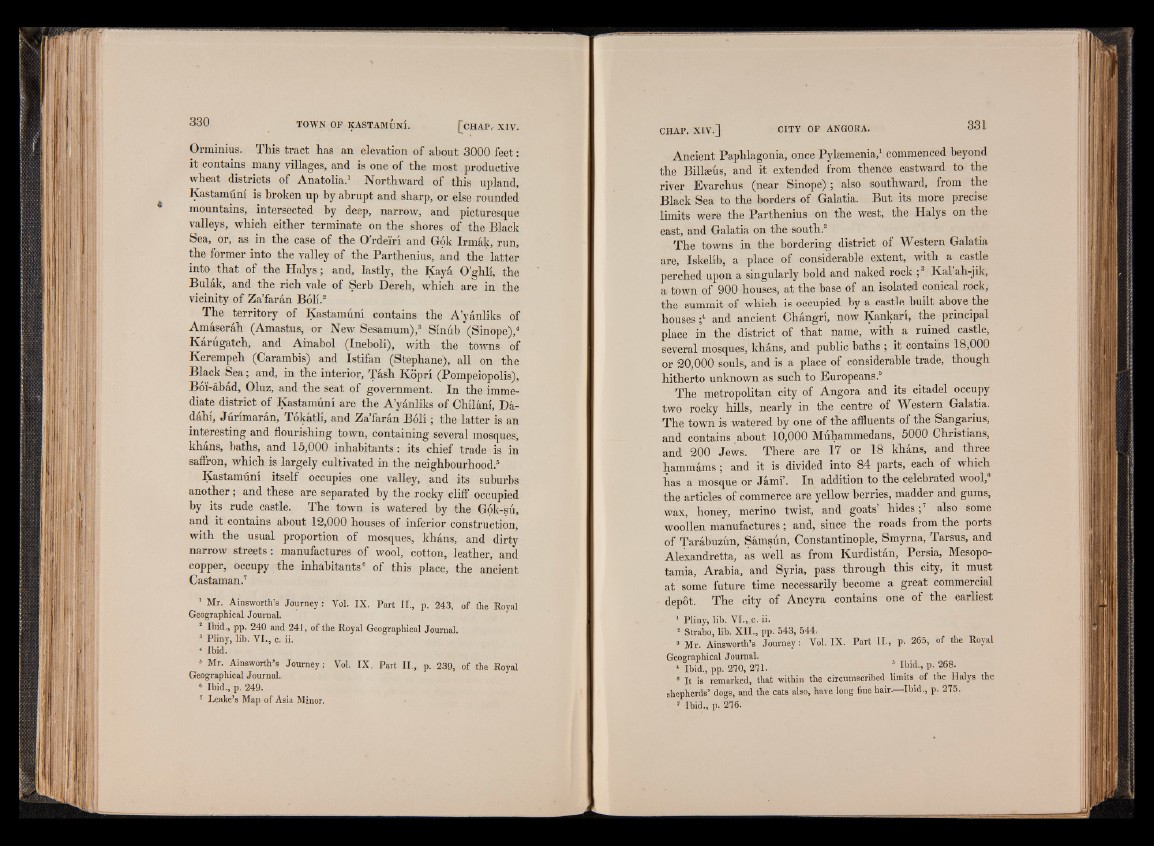
Orminius. This tract has an elevation of about 3000 feet:
it contains many villages, and is one of the most productive
wheat districts of Anatolia.1 Northward of this upland,
Kastamúní is broken up by abrupt and sharp, or else rounded
mountains, intersected by deep, narrow, and picturesque
valleys, which either terminate on the shores of the Black
Sea, or, as in the case of the O'rdeiri and Gók Irmák, run,
the former into the valley of the, Parthenius, and the latter
into that of the Halys; and, lastly, the Kayá O'ghli, the
Bulák, and the rich vale of Serb Dereh, which are in the
vicinity of Za’farán Boll.8
The territory of Kastamúní contains the A’yánliks of
Amáseráh (Amastus, or New Sesamum),3 Sínúb (Sinope),4
Kárúgatch, and Ainabol (Ineboli), with the towns of
Kerempeh (Carambis) and Istifan (Stephane), all on the
Black Sea; and, in the interior, Tásh Kopri (Pompeiopolis),
Boi-abad, Oluz, and the seat of government. In the immediate
district of Kastamúní are the A’yánliks of Chílání, Dá-
dáhí, Júrímarán, Tókátlí, and Za’farán B ó lí; the latter is an
interesting and flourishing town, containing several mosques,
kháns, baths, and 15,000 inhabitants: its chief trade is in
saffron, which is largely cultivated in the neighbourhood.5
Kastamum itself occupies one valley, and its suburbs
another; and these are separated by the rocky cliff occupied
by its rude castle. The town is watered by the Gók-sú,
and it contains about 12,000 houses of inferior construction,
with the usual proportion of mosques, kháns, and dirty
narrow streets: manufactures of wool, cotton, leather, and
copper, occupy the inhabitants6 of this place, the ancient
Castaman.7
1 Mr. Ainsworth’s Journey : Vol. IX. Part II., p. 243, of the Royal
Geographical Journal.
2 Ibid., pp. 240 and 241, of the Royal Geographical Journal.
3 Pliny, lib. VI., c. ii.
1 Ibid.
3 Mr. Ainsworth’s Journey: Vol. IX. Part II., p. 239, of the Royal
Geographical Journal.
6 Ibid., p. 249.
7 Leake’s Map of Asia Minor.
Ancient Paphlagonia, once Pylsemenia,1 commenced beyond
the Billseus, and it extended from thence eastward to the
river Evarchus (near Sinope) ; also southward, from the
Black Sea to the borders of Galatia. But its more precise
limits were the Parthenius on the west, the Halys on the
east, and Galatia on the south.8
The towns in the bordering district of Western Galatia
are, Iskelib, a place of considerable extent, with a castle
perched upon a singularly bold and naked rock ;3 Kal ah-jik,
a town of 900 houses, at the base of an isolated conical rock,
the summit of which is occupied by a castle built above the
houses;4 and ancient Changri, now Kankari, the principal
place in the district of that name, with a ruined castle,
several mosques, khans, and public baths ; it contains 18,000
or 20,000 souls, and is a place of considerable trade, though
hitherto unknown as such to Europeans.5
The metropolitan city of Angora and its citadel occupy
two rocky hills, nearly in the centre of Western Galatia.
The town is watered by one of the affluents of the Sangarius,
and contains about 10,000 Muhammedans, 5000 Christians,
and 200 Jews. There are 17 or 18 khans, and three
hammams; and it is divided into 84 parts, each of which
has a mosque or Jami’. In addition to the celebrated wool,
the articles of commerce are yellow berries, madder and gums,
wax, honey, merino twist, and goats’ hides ;7 also some
woollen manufactures; and, since the roads from the ports
of Tarabuzun, Samsun, Constantinople, Smyrna, Tarsus, and
Alexandretta, as well as from Kurdistan, Persia, Mesopotamia,
Arabia, and Syria, pass through this city, it must
at some future time necessarily become a great commercial
depot. The city of Ancyra contains one of the earliest
1 Pliny, lib. VI., £. ii.
2 Strabo, lib. X II., pp. 543, 544.
3 Mr. Ainsworth’s Journey: Vol. IX. Part II., p. 265, of the Royal
Geographical Journal.
4 Ibid., pp. 210, 271. ’ I.bid-> P- 268‘
6 It is remarked, that within the circumscribed limits of the Halys the
shepherds’ dogs, and the cats also, have long fine hair.—Ibid., p. 275.
7 Ibid., p. 276.